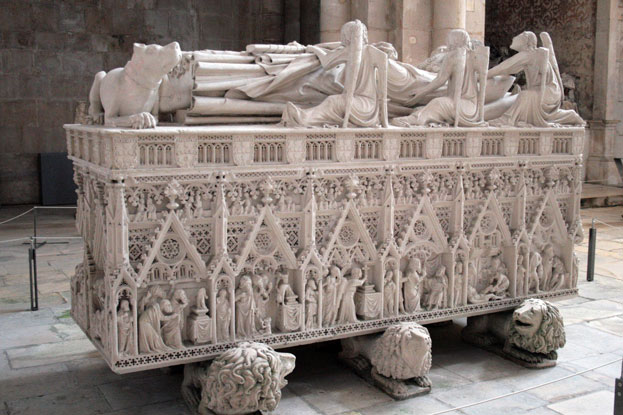The Monastery of Santa Maria d'Alcobaca, north of Lisbon, was founded in the 12th century by King Alfonso I. Its size, the purity of its architectural style, the beauty of the materials and the care with which it was built make this a masterpiece of Cistercian Gothic art. By virtue of its magnificent dimensions, the clarity of the architectural style, the beauty of the material used and the care with which it was built, the Cistercian Monastery of Santa Maria d'Alcobaça is a masterpiece of Gothic Cistercian art. It bears witness to the spread of an aesthetic style that developed in Burgundy at the time of St Bernard and to the survival of the ascetic ideal which characterized the order's early establishments such as Fontenay. The tombs of Dom Pedro and Doña Inés de Castro are among the most beautiful of Gothic funerary sculptures.

Continent: Europe
Country: Portugal
Category: Cultural
Criterion: (I)(IV)
Date of Inscription: 1989
Great Cistercian Establishment
The monastery is also an outstanding example of a great Cistercian establishment with a unique infrastructure of hydraulic systems and functional buildings. Deservedly renowned, the 18th-century kitchen adds to the interest of the group of monastic buildings from the medieval period (cloister and lavabo, chapter room, parlour, dormitory, the monks' room and the refectory).The founding of the monastery is intimately linked with the beginnings of the Portuguese monarchy. When Afonso Henriques was proclaimed King Afonso I in 1139, he based his political reconquest on the Crusaders - cruelly present in Lisbon in 1147 - and on religious orders. Alcobaça was given to the Cistercians in recognition of the victory of Santarém (1152) with the understanding that they would colonize and work the surrounding lands. The White Monks were already well established by 1153, the year of the death of St Bernard of Clairvaux, Alcobaça was, thus, the last of the saint's 'offspring' during his lifetime.
 |
| Monastery of Alcobaca Portugal |
Browse Gallery Plus UNESCO Storyline
Al-Mansoor
Despite an offensive led by Al-Mansoor at the end of the 12th century, the royal establishment began to prosper. In the 13th century, while the abbey church, laid out similarly to Pontigny, and beautiful monastic buildings were under construction, the abbey's intellectual and political influence had already spread throughout the western part of the Iberian Peninsula. It was a centre of study and religious doctrine (the kingdom's most important monastic school was there) and it enjoyed a wealthy congregation.
The abbot was a powerful ecclesiastical lord whose authority extended over the fertile lands, 13 towns, four seaports and two castles. Later, from the reign of João I to that of João IV, the abbot was appointed by the king and became a member of the Council, Grand Almoner, and Lord Protector of the Border. A number of enhancements underscored the exceptional character of this royal establishment: the Manueline sacristy of the Infante Dom Afonso, named Abbot of Alcobaça in 1505, the upper cloister of João do Castilho, one of the architects of the Convent of the Hieronymites of Belém, the facade and main part of the Baroque lodgings of Friar João Turriano (1702), and the King's Room. The ultimate symbol of this privileged relationship with the Portuguese monarchy is found in the famous tombs of Inés de Castro and Dom Pedro (Peter I).
He commissioned the twin tombs after the dramatic event that would later inspire Camoëns, Velez de Guevara and so many other contemporary authors and filmmakers. There the avenging king and his murdered queen are buried. The design of a high sarcophagus supporting the giants watched over by angels, frequently used in the 14th century, here finds one of its most perfect artistic expressions. The stylistic quality of the sculptured ornaments, even with the restoration necessitated after Napoleon's troops mutilated them in 1810-11, is surpassed by the compelling symbolism of the iconography which evokes human destiny, death and the Christian hope of eternal life. Built around 1360, the tombs are the tangible sign of Peter I's mystical rehabilitation of Inés, assassinated at Coimbra on the orders of his father Afonso IV.
Browse All UNESCO World Heritage Sites in
Portugal. The original UNESCO inscription
Here!!!











No comments:
Post a Comment